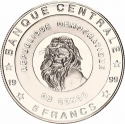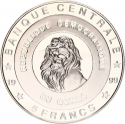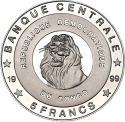You are about to finish your registration. Please check your mailbox (including spam folder). There should be a letter with a confirmation link. Check setting to make sure that your e-mail address is correct.
Send letter againDescription
Europe has 12 monarchies, including the unique systems of the Vatican and Andorra. Due to historical intermarriage, all of Europe’s reigning monarchs are related. Since WWII, all hereditary European monarchs have descended from a single common ancestor: John William Friso, Prince of Orange, who died in 1711.
Two German noble families, the Schleswig-Holstein-Sonderburg-Glücksburgs and the Saxe-Coburg-Gotha, are particularly prominent in European royal bloodlines. The British royal family, originally the Saxe-Coburg and Gotha, changed its name to Windsor in 1917 when King George V adopted a more British-sounding name to counter anti-German sentiment during WWI.
Obverse

|
Depicts the official emblem of the Laurent Kabila regime: a gilded snarling lion's head, representing strength and authority, set within a circle. The country’s name is inscribed in French, along with the date. Above, the bank's legend is displayed, and below it is the denomination, flanked by two stars on each side. ★ BANQUE CENTRALE ★ |
|---|---|
Reverse

|
Depicts a multicolored youth portrait of King George VI of the United Kingdom, Tudor Crown right and United Kingdom emblem left in the background enclosed by the inscription "King of United Kingdom" in French above, his name and reign time below surrounded by the title of the series in French. MAISONS ROYALES D'EUROPE DES SIECLES DERNIERS |
| Edge |
5 Francs
Royal Families Of Europe
King George VI of the United Kingdom
Subscribe series
KM#
Royal Families Of Europe
King George VI of the United Kingdom
Characteristics
| Type | Commemorative Issue (Non-circulating) |
| Material | Nickel Plated Brass |
| Weight | 24.3 g |
| Diameter | 38.61 mm |
| Thickness | - |
| Shape |
|
| Alignment | Medal |







